M10 isn’t just a storied hardshell—it’s a mixed climbing grade. According to the mixed climbing Wiki, the first M10 was climbed in 1998. As humans became bigger, faster, stronger and harnessed the wonders of Dyneema, carbon fiber, monopoints, and leashless tools, the Wiki unsurprisingly adds, “The grade [on this specific climb] has probably softened to M9+ over time.” M10 to M9+, a hairsplitting downgrade. But a downgrade is a downgrade.
The original M10 was released around 2010, updated in 2013, and then, off and on, sartorial spin-offs ensued. Where the original M10 featured pit zips, the 2013 vintage 180-ed to be more minimalist. No pit zips, no hand pockets, and a single Napoleon pocket. 2016 brought two harness-compatible hand pockets, a Napoleon pocket, and a slightly roomier fit. In the 2020s, the Storm M10 became Patagonia’s lightweight alpine hard shell of note. All the while, pit-zips were axed from the feature set. It’s fair to say that over the lifespan of the M10 series, there was, like the first documented M10 mixed climb, some downgrading.
If you’re caught in the busy trap here’s the 19 word review. The new M10 Storm is M10-worthy. It’s a likely hardshell upgrade to any mountain traveler’s kit. No downgrades are necessary.
A bit less busy? Here’s the one-paragraph review. Patagonia has a reputation for killing off beloved technical pieces. It goes something like this. Create a near-perfect design. A few years later, tweak that design to appeal to a broader user group. Then, after the third version, or even after one, I’ve seen that happen, poof—the sweet-ass piece is gone. No longer available. Then, years later, maybe, just maybe, it rises like a phoenix on Patagonia’s Worn Wear site. Raise your hand if you’ve regularly refreshed that site, seeking medium Knifeblade pants. I have. Oh, you too? Here’s the hot take: Patagonia nailed the new M10 Storm jacket. I may have to secure a second jacket.
Now back to our regular programming, the longform review.
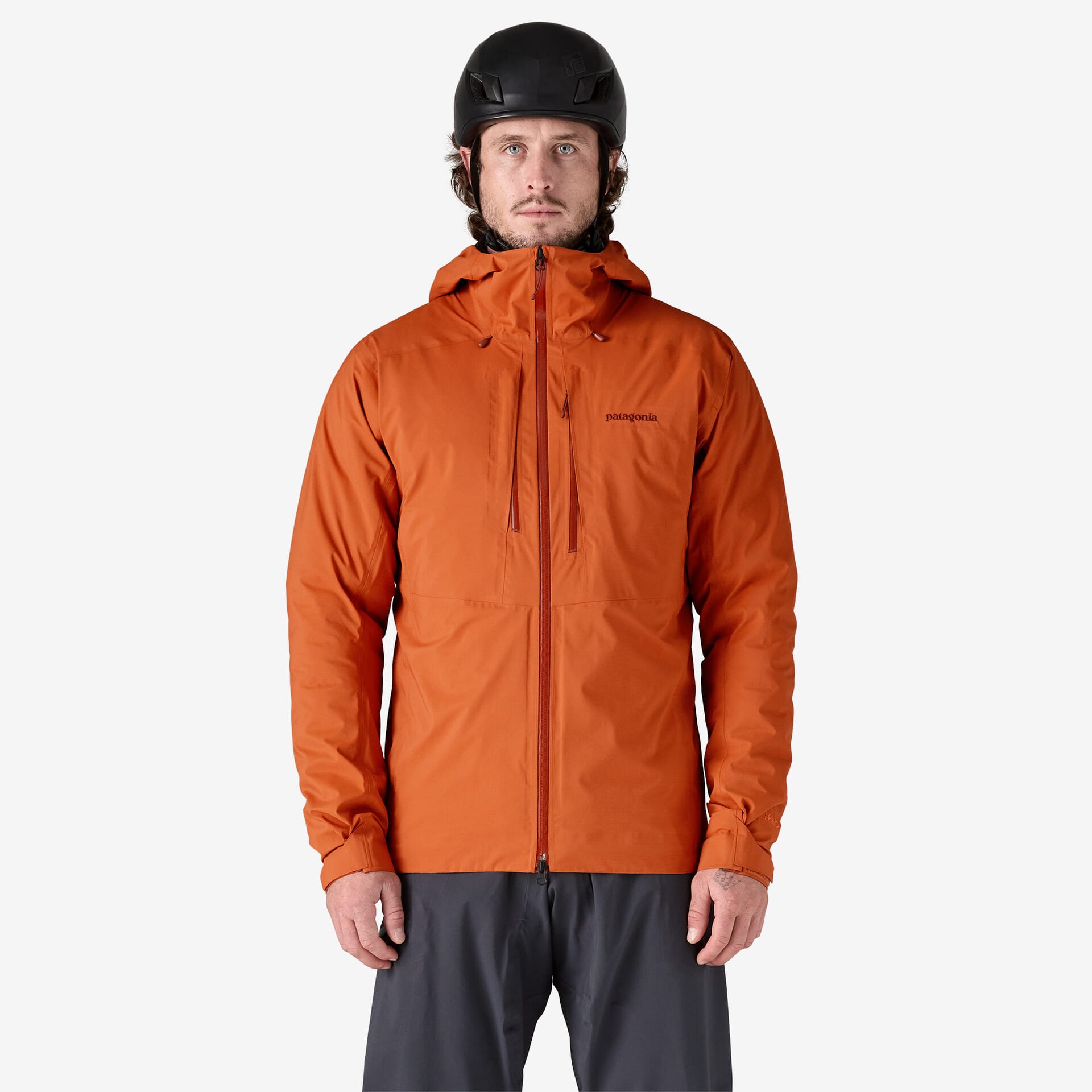
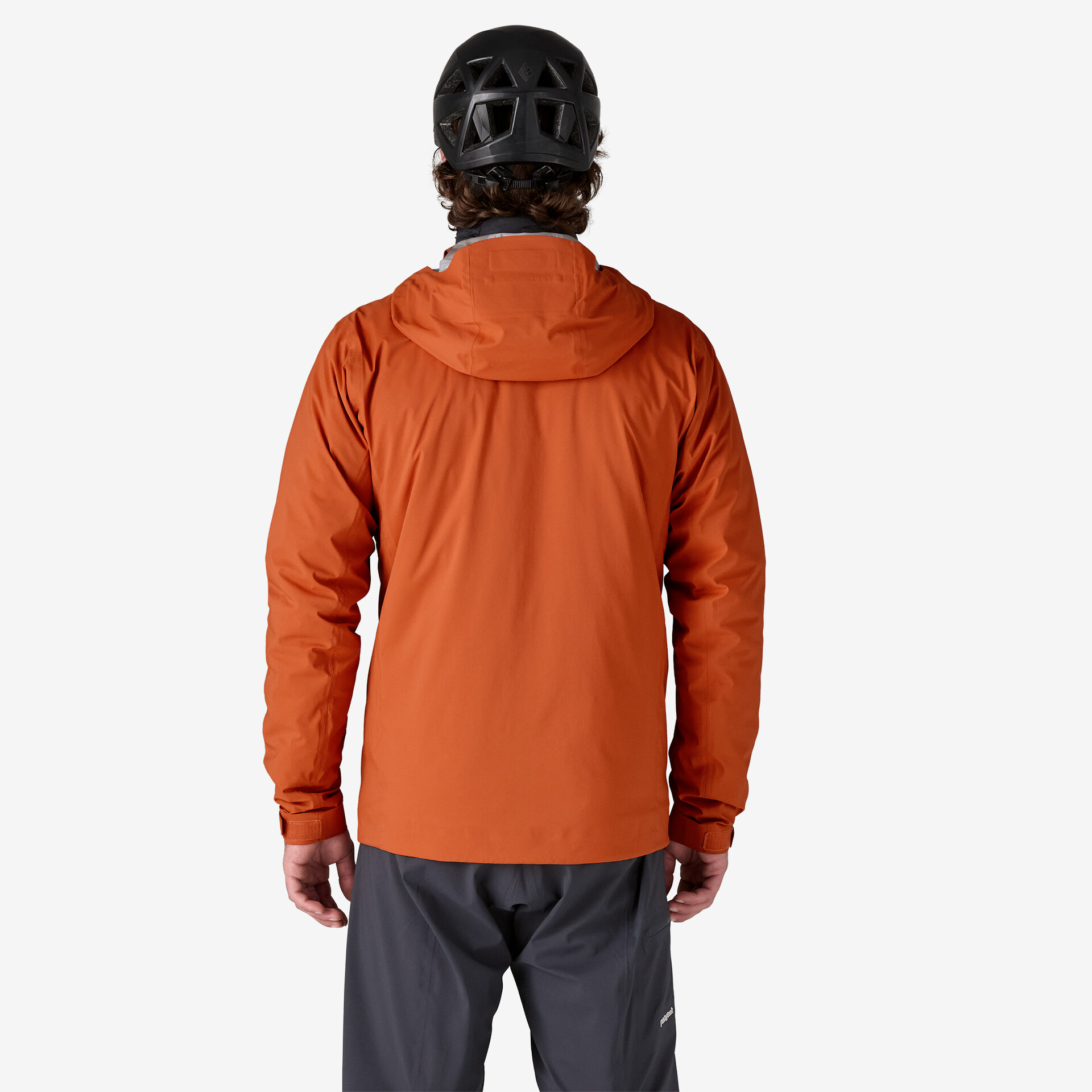
Let’s return to the idea of reputational softening—the M10 becoming a M9+. I know several backcountry skiers, one of whom is an aged-out alpinist, who speak of M10s the way a devoted Deadhead speaks of twirling at the altar of their favorite Scarlet-Fire. These conversations ooze the notion that things aren’t what they were or could be—the M10 hardshell may be more M7-M7+, not so much M10 since the late 20-teens.
It’s now 2024, and Patagonia releases two M10 spin-offs this fall. There’s the M10 Storm full zip jacket, reviewed here, and the M10 Anorak, a ⅔ front zip affair with a slightly different 3L configuration, and, at least to this person, a noticeably slimmer fit. We tested a size medium M10 Storm and tried a medium M10 Anorak for sizing—the medium anorak was tough to slip on and comfortably articulate my arms. This, too, looks like a sweet piece. Size appropriately.
Fit
The M10 Storm’s sizing leans into the “less is more” axiom. There is just enough material here and there to make raising your arms overhead smooth and easy. The arm length is ideal (it is designed for reaching overhead ice climbers). Don’t expect a ton of snow to wash into your gloves/mittens due to cuff creep while skiing/riding/ascending. Across the chest, the fit trends towards the snug side. If you layer with thicker and bulkier underlayers, or your lats and chest are swole, think about sizing up. The sizing worked for layering over a thin baselayer and an Arc’teryx Proton LW: I’m 5’10”, around 160 pounds, and not swole. FWIW, I opt for layering a synthetic fill puffy over a hardshell. If I were layering the M10 Storm over the puffy, I’d snag a large.
The waist/hem sits where the crotch and leg interface (is there a name for that part of the anatomy?). Although the M10 Storm is a climbing-focused hardshell, the hemline is not too short, yet it runs slightly shorter than some more ski-specific offerings. I used the M10 Storm almost every day of skiing from February through the spring and never found the hemline lacking relative to the snow depth. (Note: I’m not in Japan.) A simple cinch tightens an elastic cord to close off the hemline.
Traditionally, as far as an active fit is concerned, alpinists and climbers don’t trend baggy. This is not a baggy free-ridey-fit. Patagonia calls the M10 Storm a “slim“ fit“ This designation is as advertised and aligns with the intended user group and ski tourers eyeing a minimalist kit; if you are still seeking baggy and minimalist, size up for baggier and better coverage below the waist.
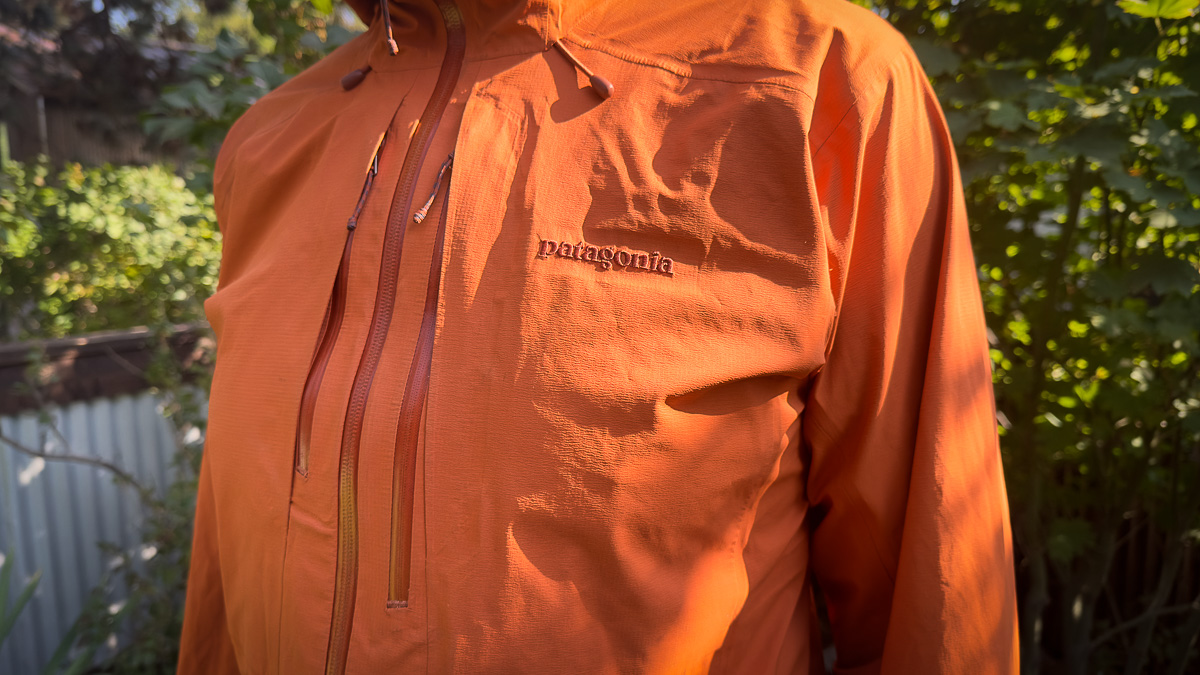
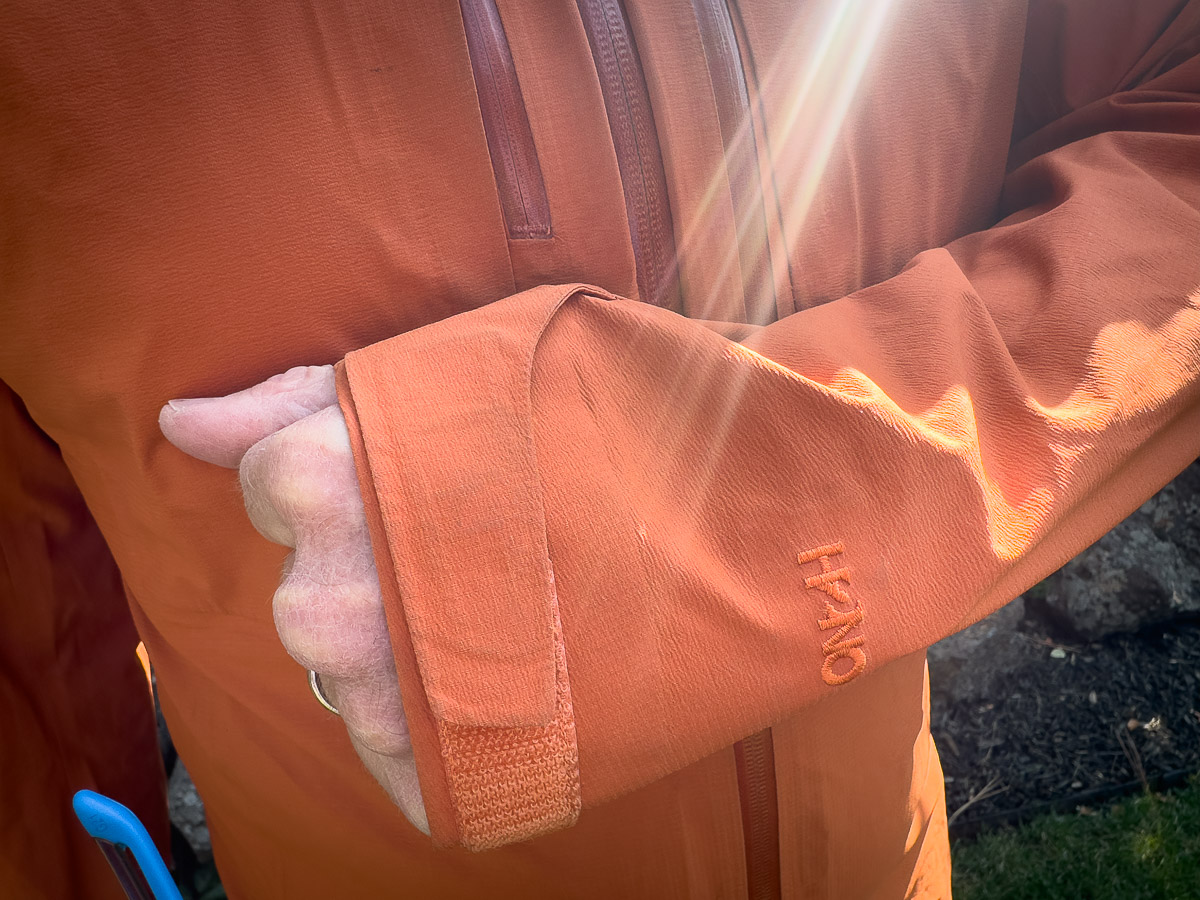
Features
Let’s run through this feature by feature and peel back some layers in this 3L piece.
Weatherproofing: The M10 Storm meets Patagonia’s H2No performance standard. That’s correct; H2No is a standard, not a specific material like Gore-Tex Pro. The standard meets waterproofness, breathability, surface repellency (think DWR finish), and durability benchmarks. Before publishing, I’ll shower with the jacket on to confirm/deny the weatherproofing. But here’s the gist. I’m rather unkind to my gear. I beat the M10 Storm up. Knowing this is intended to be a low PFC/PFAS product, I kept an eye on face fabric dirtiness and washed the jacket as needed for a repellency refresh.
On snowy, sleety, and rainy days, I remained dry wearing the M10 Storm. It was machine wash time if I saw portions of the face fabric wetting out. (I have yet to refresh the DWR with a third-party renewal option.)
I also come to this with an understanding that today’s hardshells are not as “weatherproof” as yesterday’s hardshells; that’s the cost or benefit (it depends on how you look at it) for removing fluorocarbons from our outdoor clothing. I’m also not often cruising around the backcountry in a downpour. I do cruise around and storm ski, though. In our PNW weather, the M10 Storm weatherproofing has been sufficient. The 3L fabric + DWR, weatherproof zippers, and taped seams assist with keeping the moisture out.
I used this jacket for a solid five months, including a 10-day ski traverse. Still, there were no performance issues with the waterproofness. The piece also shuts down wind—this is a zero CFM fabric, meaning the M10 Storm can serve as a pricey wind blocker if you live in a rather dry climate.
The face fabric is a 2.6-oz 30-denier ECONYL® 100% recycled nylon ripstop. The backer is a 7-denier knit. Seams are taped and sealed. To put things in perspective, Patagonia’s time-tested Triolet jacket has a beefy 75-denier face. Having already stated I’m unkind to my gear, the face fabric has proven durable. However, I’m certain a battle with a tree branch at normal descending speeds goes to the branch. That’s the case with most hard shells.
You’re likely opting for the M10 Storm because it’s a minimalist hardshell. Minimalism means less overall weight while still providing optimum performance when and where it counts. With the M10 Storm, you get 300g (that’s right, 10g less than the claimed weight) of righteous hardshell. Sweet! Am I giving up some durability? According to the actuaries and alchemists, I am. Unsweet! Life is full of tradeoffs.
But this less-durable hypothesis, so far, has yet to play out. The 2.6-oz. 30-denier material provides. And if it begins to unprovide, because we are thrashing these pieces in the mountains, there’s Ductatpe and a whole ecosystem of kick-ass outdoor fabric patches to add some patina. The M10 Storm gets the balance and trade-offs between weight, durability, and functionality right. (Big note: we did not spend a winter and spring rubbing up against granite and ice smears; we did hammer this jacket while touring but did not use it as an alpine climbing objective-specific hardshell.)
There’s a pattern here. Less is more.
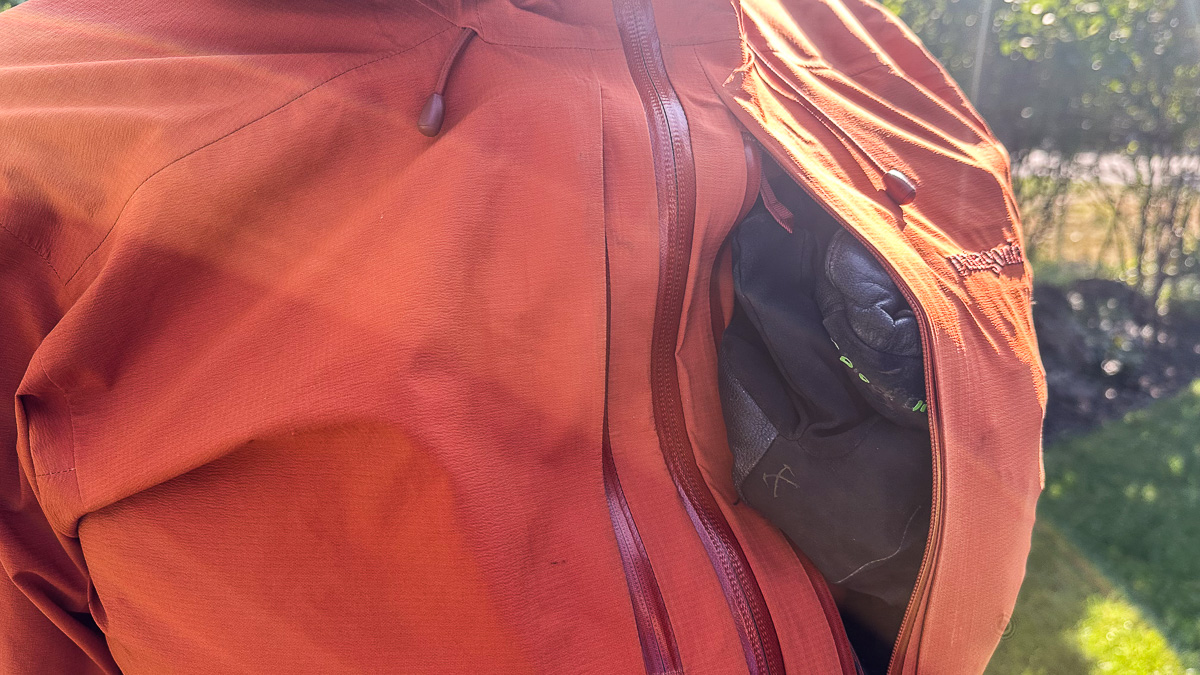
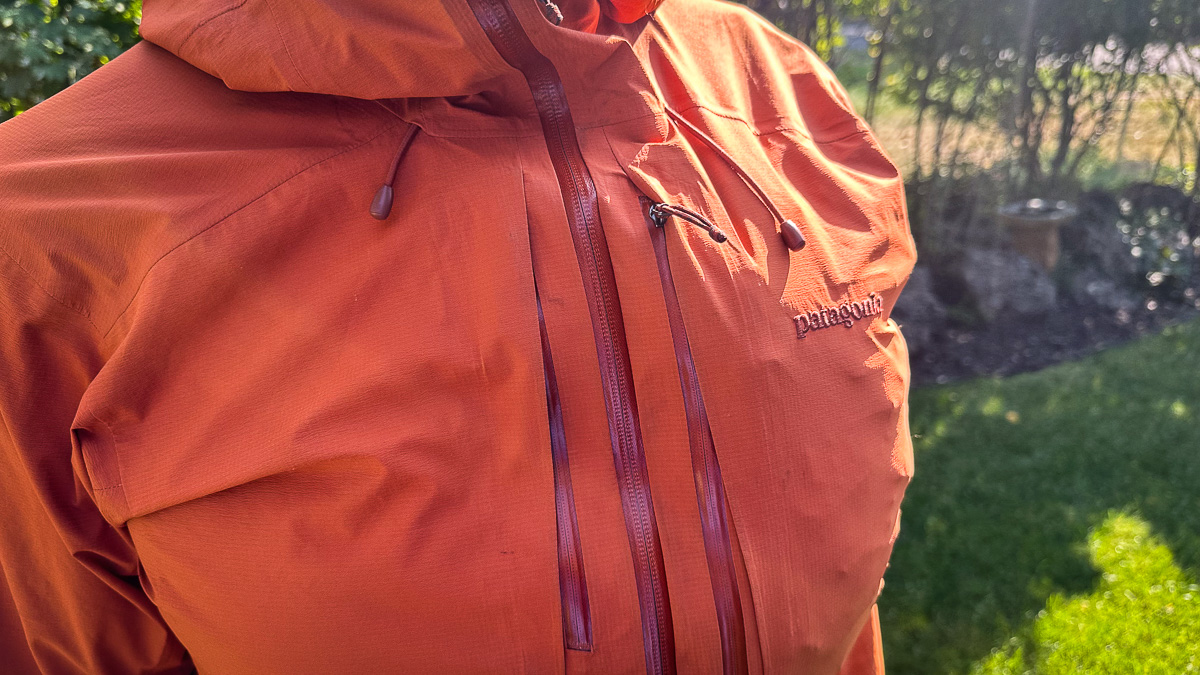
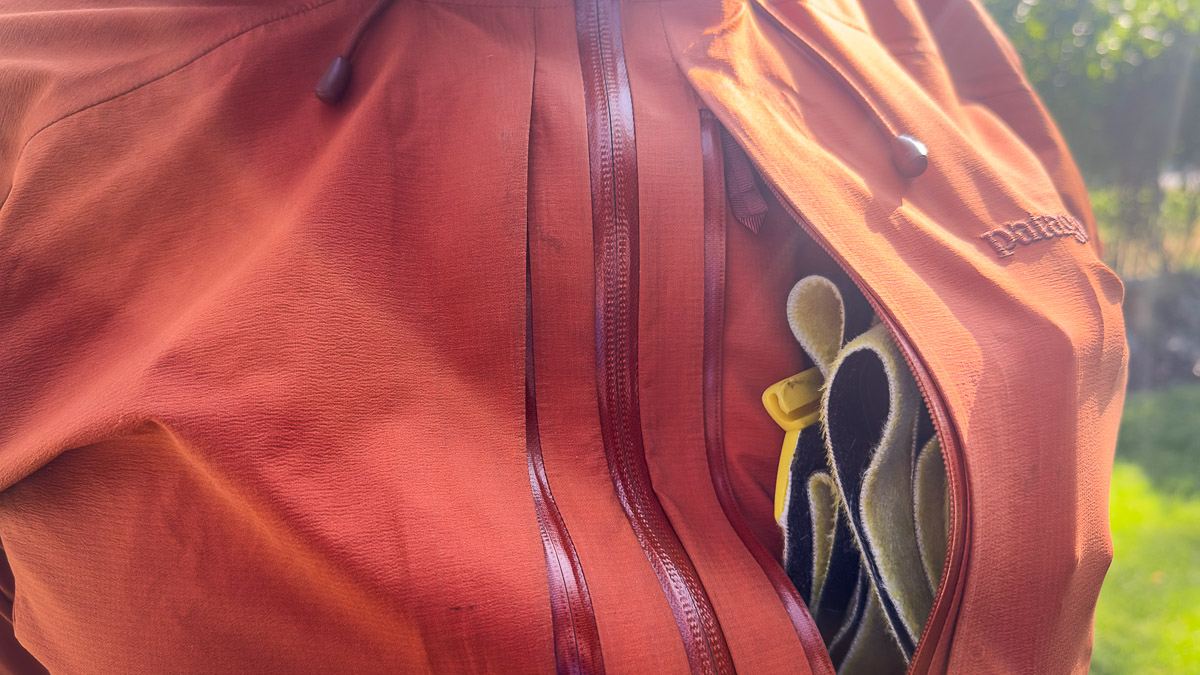
Pockets
Simple and perfect. It comes down to this: Two Napoleon-style chest pockets with waterproof zips. The pocket arrangement and functionality are more than A-Ok. The left chest pocket is fit with a larger opening/zipper for bigger items. (The pockets’ volumes are identical.) Inside is ample room for technical gloves (like the BD Enforcer) or items like lightweight liner gloves, sunblock, and sunglasses. The right side pocket with the smaller opening, is nice for housing a phone and sunglasses. The point here is that my storage needs are fulfilled with the two chest pockets.
I’ve yet to do this, as I usually ball up my jackets and shove them in the pack; the left chest pocket serves as a self-stuff sack with a carabiner clip loop.
Less is more.
Although the designers went with two chest pockets instead of one, as with older M10 iterations, the more pockets here are, in fact, less. As in, less fussing and whining about why jackets don’t feature two modestly sized chest pockets and call it good. This jacket does that. Lastly, the absence of hand pockets is not an abomination here. If you wear a pack with a waist belt, which you likely do, hand pockets and the items you store there would get in the way.
Hood
The hood is a classic helmet-compatible affair. It has two quick adjustments on the left and right collar for fine-tuning. A single spring-loaded cord lock sits behind the head to release unwanted tension from over-adjusting. It’s functional with a single hand. The brim is sufficient to ward off water dripping into the face and houses a Recco reflector. One caveat: I ski with a Peztl Sirocco helmet, a notably lower profile helmet than a proper ski helmet.
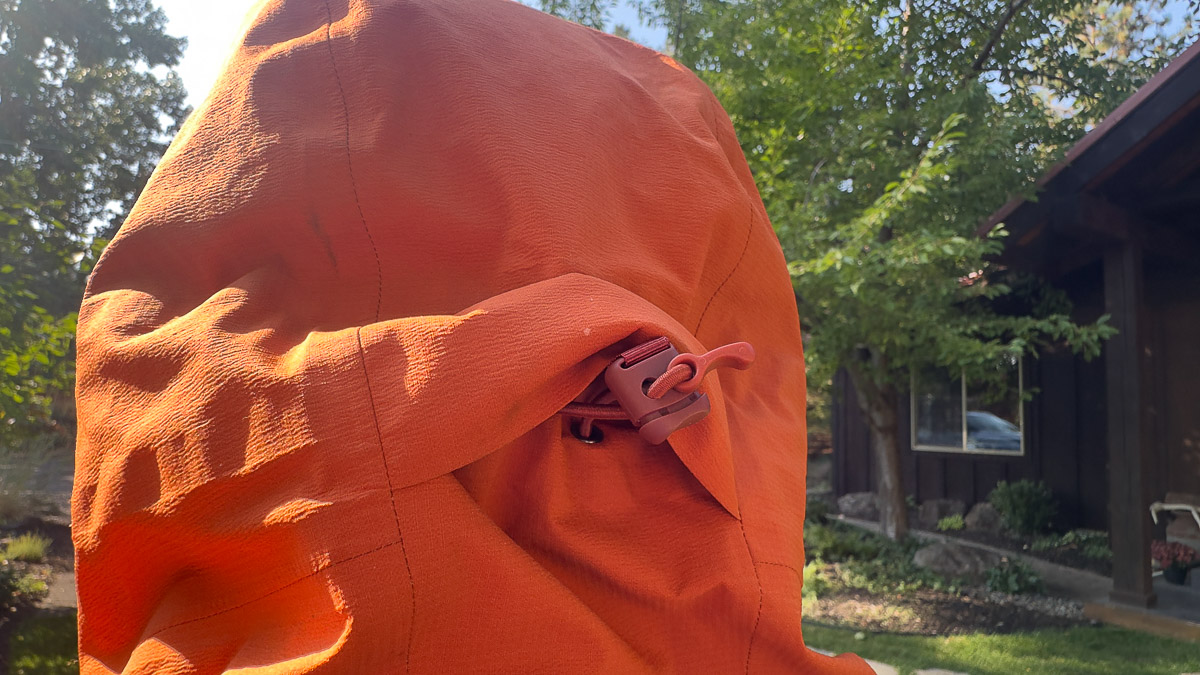
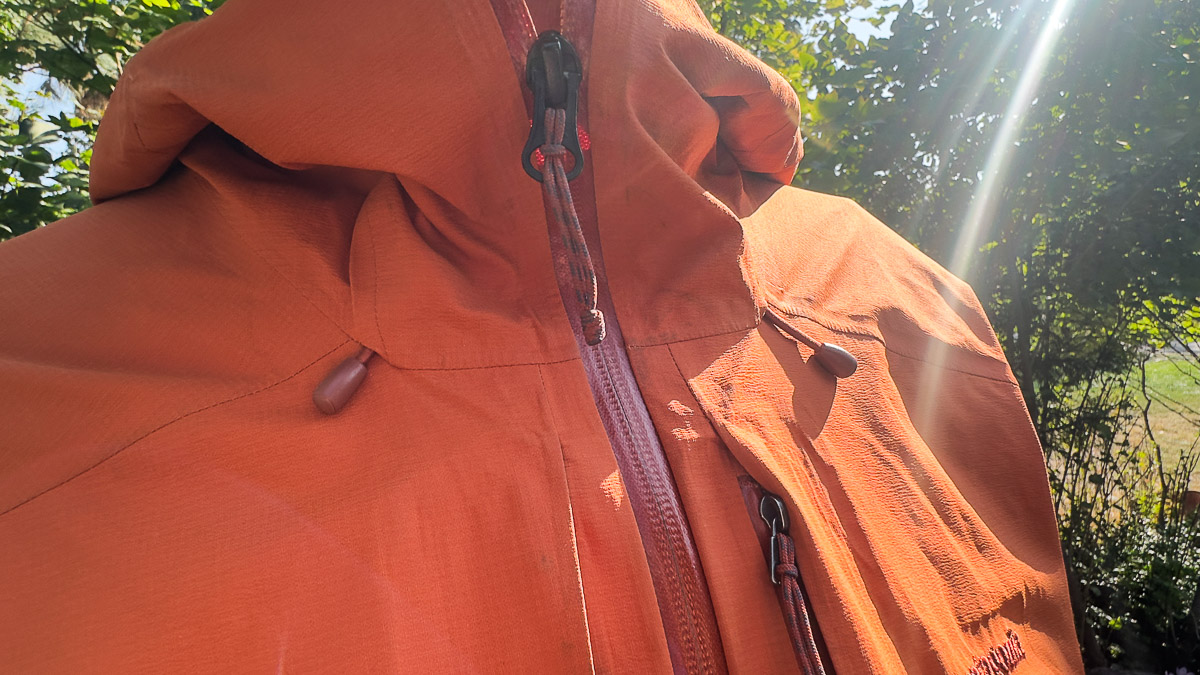
Two Way Zipper
We like two-way zippers. And this piece sports one. Two-way zips offer the option of opening a front zip from the top or the bottom. Two things. If you are a rock climber, this piece can serve double duty as a climbing hardshell and your ski/ride hardshell in winter. A two-way zip is a simple, efficient way to dump heat. You can open the front from the top and bottom, which may be preferable when overheating in windy and modestly inclement weather. And if you are a skier/rider already wearing a harness, say for glacier travel, and you toss the M10 Storm on because the wind kicks up or temps drop, the two-way zip allows one to still access the harness belay loop.
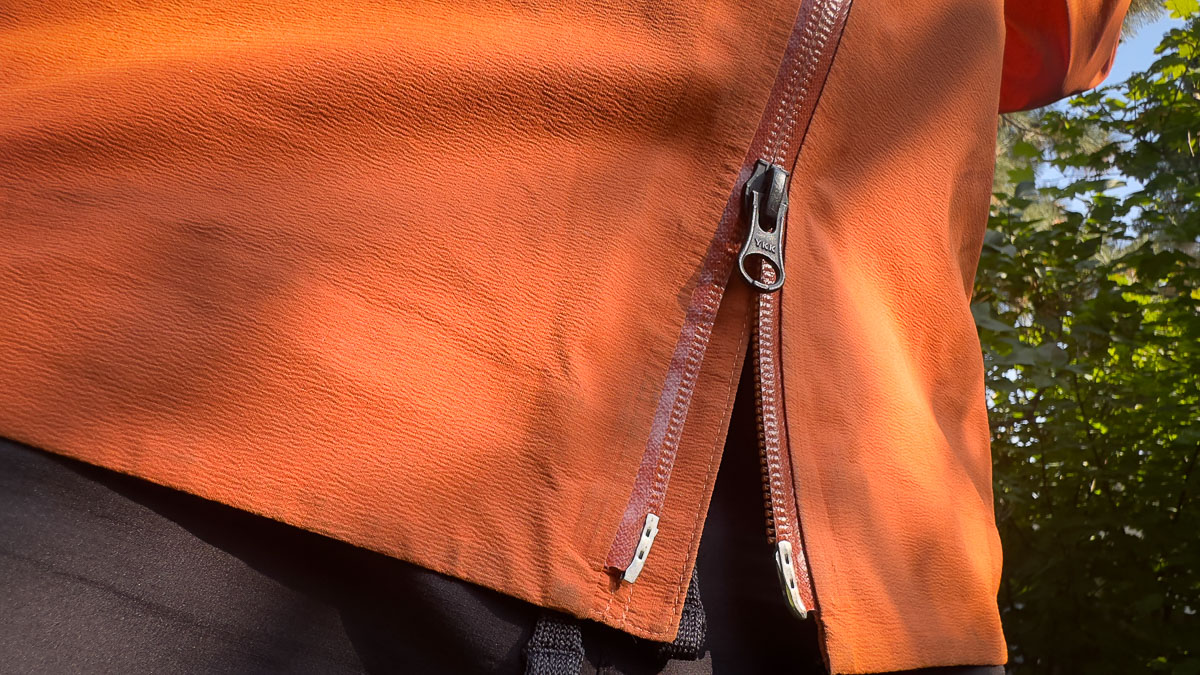
In the Field
Breathability is an often-referenced hardshell attribute. However, over the years, I’ve leaned into a hardshell jacket’s breathability with less earnestness. The times I’ve been in a high output rhythm and needed to be fully bundled up, as in hardshell lockdown mode, are rare. We won’t dive into the physics of moisture management here. But, the basics apply: Work hard, and you will sweat and off gas water vapor. Ideally, water vapor transports out of the jacket (through the membrane). Sometimes, that mode of transport is insufficient. The two-way zip helps dump heat fast. Pit-zip lovers, we know you are out there, and we respect that, look elsewhere for a hardshell.
The M10 Storm, in my experience, breaths sufficiently well. My go-to layering systems are lighter layers for skinning/hiking/cramponing unless it is super windy and/or cold. Then, I’ll wear a hardshell or lightweight windbreaker to shut down wind. The jacket’s breathability was a non-issue when wearing my usual baselayer t-shirt and thinner mid-layer hoody or the Arc’teryx Proton LW on colder days. If I suspected I might overheat and still desired the hardshell, I often just wore my t-shirt as an underlayer. This all helped minimize sweat and overheating. I stayed dry on the inside.
Skiing, descending, building camps, breaking down camps, and living life in the hills is a non-issue with the M10 Storm. There’s a wee bit of stretch in the fabric, making for excellent articulation—which makes the life-living all the more desirable when wearing the M10 Storm.
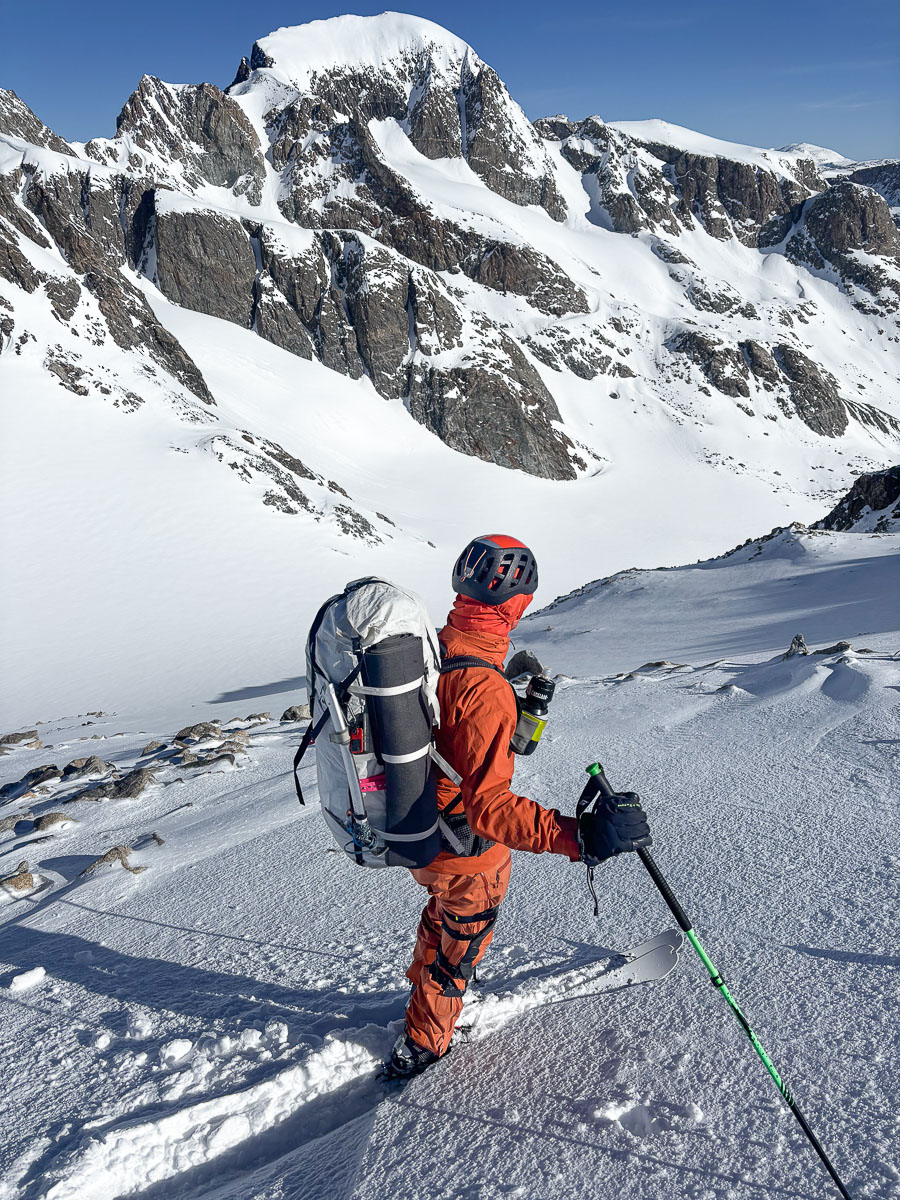
To Close it Out
I’m a weight weenie in some scenarios. What I’m most concerned about with my clothing, and for that matter, bindings, poles, packs, and boots, is finding a balance between lightweight and high function. I apply the principle that hauling overbuilt gear into the backcountry is a waste. I’m still determining who said or popularized it, but I’m not keen on having gear designed for 5% of the time but using it for the remaining 95%. For example, do I need a heavy denier Gore-Tex Pro shell 95% of the time? (Insert thumbs-down emoji.) The M10 Storm helps me find a more logical balance.
As with any minimalist product, durability could be an issue. Although the M10 Storm has been in use (including summer use) for roughly eight months, despite some dirt buildup on the face fabric, the piece holds up. This morning’s shower test went like this: 8 minutes under a steady stream of water with a cotton T-shirt as my underlayer. The DWR finish, all these months later, holds strong. The T-shirt was 100% dry after the shower. The fabric at the cuffs did wet-out slightly.
The classic shower test. 8-minutes or so in duration. After 8-months of use, the DWR and general weatherproofing hold up.
The reality is that alpine minimalism and the clothes designed for that practice are often well suited for 95% of our backcountry time. There are no extras to haul around, just the needed basics—nothing overbuilt. I wouldn’t call the M10 Storm a specialty piece. For us ski tourers, and you too, riders, it can be an all-arounder, a day-to-day hardshell. And keeping it in your pack for the just-in-case moments won’t weigh you down.
Our hope is that Patagonia sticks with this basic design as the M10 jacket line evolves. Fit and pocket orientation can make or break a hardshell. We love what they have done. Although this piece is in Patagonia’s alpine line, we’ll claim it. We’re glad the jacket can swerve hard out the alpine lane and double down as a reliable backcountry touring/ski mountaineering hardshell. The M10 Storm comes in a women’s specific model.
The Basics
Price: $379
Weight Men’s M: 300g (confirmed)
Fabric upsides: No intentionally added PFAS and a wee bit of stretch for excellent articulation.
Face Fabric: 2.6-oz 30-denier ECONYL® 100% recycled nylon ripstop
Backer: 7-denier knit.
Waterproofing: 3L fabric and durable water repellent (DWR) finish are made without intentionally added PFAS.

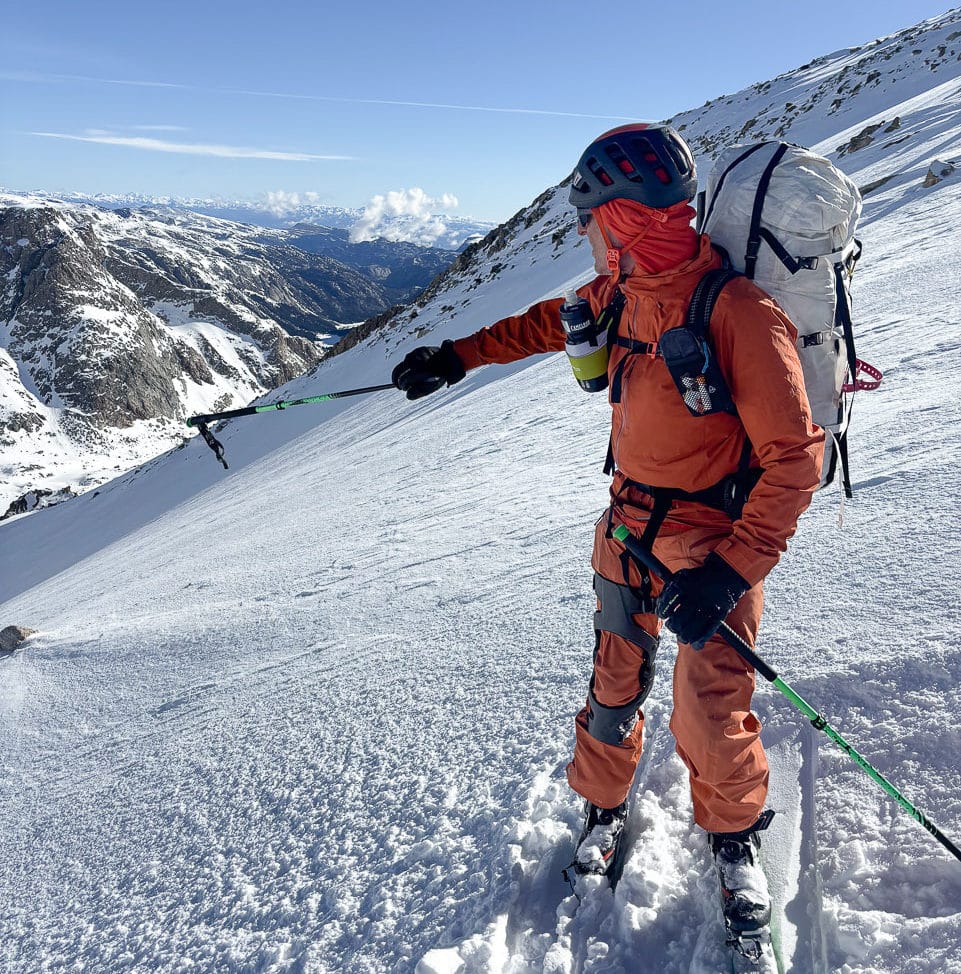




Leave a Reply
You must be logged in to post a comment.